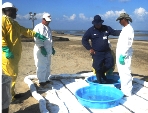The U.S. Geological Survey has purchased $3.4 million of high tech electro-acoustic instruments from SonTek/YSI.
Digital photography can replace certified smoke readers to measure opacity.

RS Hydro will install more than 250 flow monitoring stations for the cement supplier, using Siemens and Adcon technologies.
In the class action lawsuit, the firm alleges BP and Nalco knew that COREXIT was toxic to the biosystem and the food chain.
The revised regulation requires CAFOs that discharge to seek coverage under the National Pollutant Discharge Elimination System permit.
With the simulation of heavy rainfall, E. coli increased slightly, the researchers said.
The company's Munox product naturally biodegrades petroleum.
Two professors will try to find ways to accelerate the chemical breakdown of hydrocarbons using naturally occurring marine organic matter.
The sorbent material recently was approved for use by the U.S. Environmental Protection Agency.
B&R Enclosures offers these tips for keeping stainless steel looking its best.
Covering 10 percent of a watershed with impervious cover can cause as much as one-third of a decline in pollution-sensitive aquatic insects.
University of Arkansas research suggests hydrochlorofluorocarbons, which were meant to protect the ozone, may contribute to climate and acid rain problems.

Dredging equipment, vacuums, and imaging equipment are working to help restore the Gulf of Mexico's beaches and other inland areas.
Baron & Budd attorney says Gulf of Mexico cleanup workers should be monitored or warned about the health hazards.

Between 35,000 and 60,000 barrels of oil per day may be leaking from the BP oil well in the Gulf of Mexico.
Abanaki product adds surface area and can be retrofitted to existing drum or disk skimmers.

Researchers from several organizations tested visible near infrared light with diffuse reflectance spectroscopy to determine the presence and amount of oil in Louisiana soils.
The U.S. Department of Agriculture's Animal and Plant Health Inspection Service has quarantined specific areas, and if you are moving from one of them, you had better get an inspection certificate.
Working for TVA, the lab is continuing its research to determine if selenium and other contaminants will have a long-term effect on fish populations.